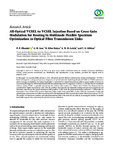All-Optical VCSEL-to-VCSEL Injection Based on Cross Gain Modulation for Routing in Multinode Flexible Spectrum Optimization in Optical Fibre Transmission Links

View/
Date
2019Author
Isoe, G. M
Dlamini, P. P.
Isoe, G. M.
Boiyo, Kiboi
Leitch, A. W. R.
Gibbon, T. B.
Metadata
Show full item recordAbstract
In this paper, we experimentally present a novel, all-optical spectral efficient vertical-cavity surface-emitting laser- (VCSEL-)
based technique for routing and spectrum assignment in optical networks. Exploiting all optical VCSEL-to-VCSEL injection to
attain cross gain modulation, the optical transmitter is optimized for optical transmission paths to assure quality of service by
overcoming blockage for differentiated bandwidth demands during network congestion incidences. A 10 Gbps directly modulated
1549 nm master VCSEL is optically injected into the 1549 nm side modes of a 1550 nm slave VCSEL. +e Shannon limit is
considered for higher transmission rates with the problem decomposed into degraded routing and spectrum assignment and
chromatic dispersion in the optical transmission link penalties. In this work, the proposed technique achieved a 1.3 dB penalty for
transmission over a 25 km G.655 nonzero dispersion-shifted single-mode optical fibre, a value within the transmission media and
optical system characteristics of 3 dB as recommended by the International Telecommunication Union-Telecommunication (ITU-T).
+e number of transceivers, switches, and optical transmission links in the network was reduced, increasing the number of satisfied
bandwidth requests, thus optimizing the spectral resource utilization.
